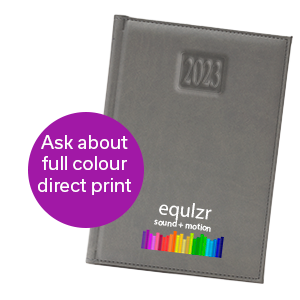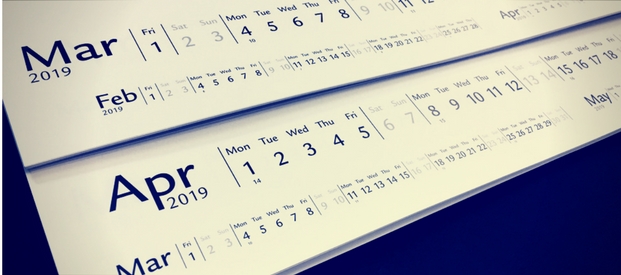Can you see a calendar in your mind?
Just imagine how convenient it would be if you could see your own calendar set out before you. No need for diaries, wall calendars or any other device, just your own personal calendar, clearly visible and always with you. For some people this is reality. Known as ‘calendar synaesthetes’, this small minority of people can see the year, months and days quite clearly. They can scan forwards and backwards through the months, just as the rest of us would do with a real calendar.
Most calendar synaesthetes see the calendar as a line with the dates stretching from left to right. One individual describes the weeks and months as an ascending line curving towards his left, with different periods of the year in different colours. The line moves so the present is always at the centre, and he can zoom in or out to see his whole lifeline.
Others see their calendars as a big ring stretching out before them with the months in fixed positions. One describes the whole circle as being about 15 feet in diameter. Another sees a similar ring but with the current month always directly in front of her. Another woman’s months are in different colours in a distorted oval that goes right around her, tilted up at the front and downwards behind.
What is calendar synaesthesia?
Synaesthesia in its simplest form is described by the UK Synaesthesia Association as ‘a “union of the senses” whereby two or more of the five senses that are normally experienced separately are involuntarily and automatically joined together.’
We know that our brain processes messages from our eyes, ears, mouth, nose and sense of touch. During our first few years of life, our brain makes more connections than it needs, and then eventually prunes away some of the less useful connections. It may be that people with synaesthesia have retained some of those extra connections.
Calendar synaesthesia, also known as spatial sequence synaesthesia, is a rare form. Those who have it visualise numerical sequences or calendars in physical space.
Mental image or genuine sensory experience?
Do calendar synaesthetes see a mental image or it is a genuine sensory experience? Helen Thomson (New Scientist, November 2016) reports on a study at the University of California in which Vilayanur Ramachadran and his team of researchers performed a series of tests to find the answer.
ML sees her calendar as an asymmetrical ‘V’ shape, with the months written in Helvetica script. The team asked ML to name the months of the year backwards, skipping one or two months each time. She was able to simply read the months from her calendar, and completed the task much faster than the eight non-synaesthetes tested at the same time.
‘During the task we noticed that ML appeared to be inspecting her calendar,’ Ramachandran tells Helen Thomson. ‘She would involuntarily move her finger from month to month and shift her gaze.’
Next, the team asked ML to look at a contracting spiral for a short time and then transfer her gaze to a static image and to her mind’s eye calendar. As is usual in this well-known visual illusion experiment, ML reported that the static image expanded. Surprisingly, her calendar also expanded. However, if she tried to imagine an apple and look at it after gazing at the spiral, it did not expand. This suggests the calendar is not the same thing as a mental image. It is a genuine sensory perception.
EA sees her calendar in the shape of a hula-hoop in front of her chest, with December passing through her body. When she turns her head the calendar remains stuck to her body and doesn’t move with her eyes. What’s more, when she turns her head to the right or left, the months on the other side of her calendar become ‘fuzzy’ and memories of those months are harder to access.
‘This is one of the most striking examples of “embodied cognition” that we know of,’ says Ramachandran. ‘This is the idea that our bodies and their relationship with the environment have the ability to govern our thoughts, emotions and speech. In EA’s case, access to her memories appears to be influenced by the movement of her neck and eyes.’
How do we function without it?
Surely there must be a down-side to being a calendar synaesthete? Contributors to an online synaesthesia forum don’t seem to think so. It’s known that calendar synaesthetes have great memories, and people on the forum report such skills as being able to repeat conversations word for word, recalling friends’ exam grades going back many years, and remembering what everyone was wearing at certain events.
One woman tells us, ‘I rarely use a diary as my own calendar is so effective.’ Another young woman’s calendar is so good that she always remembers the birthdays of everyone in their large extended family – much to her mother’s amazement.
In fact, far from expressing negatives about calendar synaesthesia, those who have it wonder how the rest of us manage without. One curious synaesthete asks how non-synaesthetes think about time, saying ‘I don’t understand how people can function without visualising it.’











I have this Calendar Synaesthesis , I agree with all that is mentioned above , remembering birthdays from my minds calendar my mind is a calendar that i can refer too since i was young. I only realised i have this because when i bought a calendar to remind myself to do certain things I couldnt seem to see it in my mind the same as it is shown on calendar , and it was confusing my own internal calendar…I actualy see a calendar in my mind..week days form a lockwise oval loop in front of my eyes .
How interesting Louise! It is fascinating to imagine how you might visualise a calendar in your mind, and how convenient to be able to recall birthdays and occasions.